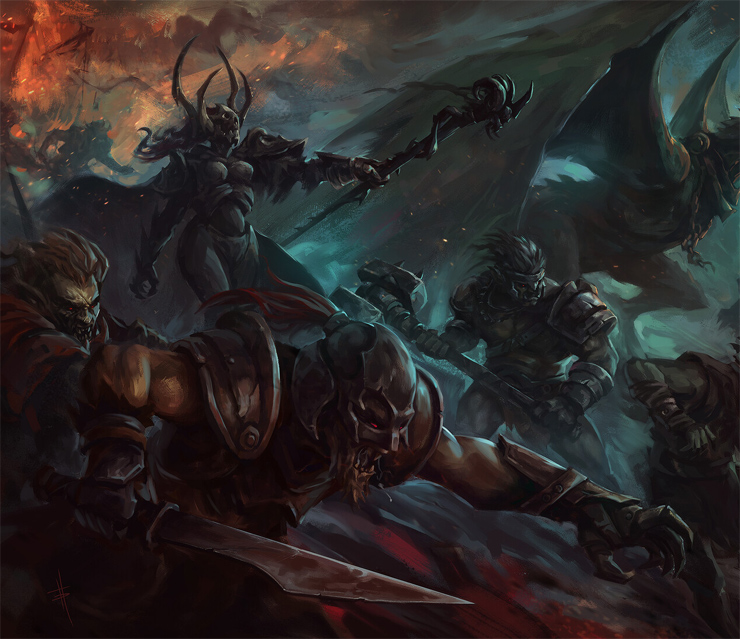In this scattershot series, we’ll be delving “too greedily and too deep,” prying gems out of the glorious rough that is the extended legendarium of Tolkien’s world. This includes drawing on The Lord of the Rings itself, The Hobbit, The Silmarillion, The Children of Húrin, and the History of Middle-earth (or HoMe) books.
What are little orcs made of?
Heats and slime
And Utumno’s vile grime
That’s what little orcs are made of
Maybe? Well, only at first.
This, then, is my final installment on the topic of J.R.R. Tolkien’s Orcs, whereas the professor himself was never final about it. Orcs were, for him, the subject of “prolonged interior debate” (so wrote his son, Christopher) after the publication of his most famous work. This time we’re leaving The Hobbit, The Lord of the Rings, The Silmarillion, and Unfinished Tales all behind and going right to the 12-volume series known as The History of Middle-earth (or HoMe), to see what information we can scare up.
Let’s hunt some Orc-lore!
After the publication of The Lord of the Rings, Tolkien wrote this about the Orc problem, as recorded in Morgoth’s Ring:
Their nature and origin require more thought. They are not easy to work into the theory and system.
This is, from what we’ve seen before and what we will see in the HoMe books, an understatement, and he was right to think it. Tolkien dropped a number of axioms about Orcs and about the theology of evil that don’t all add up neatly. Let’s reason through them and see what’s been said about Orcs across the years
First, a quick summary of what these books are: The History of Middle-earth books are the (mostly) unrefined tales, essays, and assorted bits and pieces of Tolkien’s legendarium. They contain writings that preceded The Hobbit, early drafts of The Lord of the Rings, post-Rings debates, and a number of retcons and treatises that J.R.R. Tolkien was in the process of devising but never saw through to completion. The entirety of this series was carefully curated and published by his son Christopher Tolkien, tracking the development of Middle-earth and its environs.
A very short glossary is in order, which may be helpful amidst the ever-changing names in Tolkien’s mind. Especially as some alternate frequently.
- Avari = the Unwilling Elves who refused to even try for Valinor
- Children of Ilúvatar = Men and Elves
- Eru = Ilúvatar = the “Lord for Always who dwells beyond the world; who made it and is not of it or in it, but loves it”
- Glamoth = Orcs and goblins, “the din-horde,” or “folk of dreadful hate”
- Gnomes = Noldoli = Noldor = those Elves who set off on the journey to Valinor and came back again
- Incarnate = creatures like the Children of Ilúvatar, designed to possess both a fëa (spirit) and a hröa (body)
- Melko = Melkor = Morgoth = the ex-Vala, the Dark Enemy of the World
- Sindar = Elves who started for Valinor but stayed in Middle-earth
- Tu ≈ Tevildo ≈ Thû ≈ Sauron = sometimes a seemingly independent contractor of dubious character, sometimes the mightiest of Melkor’s servants
- Valar = the Powers, the little-g gods of Arda, such as Manwë, Vard, Ulmo, Aulë
- Valinor = the land of the Valar
Having said all that, let’s dive in to the very eldest of days with…
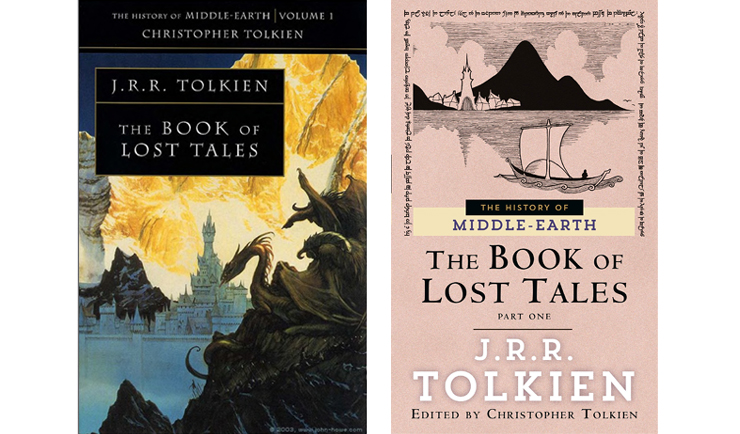
Volume 1: The Book of Lost Tales, Part One (1983)
The earliest version of Middle-earth, which preceded even The Hobbit, can be found in this book. It presents a frame for, and a beginning of, what would become The Silmarillion many years later, and it includes the creation myth (the Music of the Ainur), the discord of Melko, the awakening of the Elves, the exile of the Noldoli, the first rising of the Sun, and the arrival of Men on Middle-earth. There is little lore in this book (or anywhere in the HoMe series) that should be considered carved in stone, as these unrefined writings never saw publication during Tolkien’s lifetime. Yet if The Book of Lost Tales is like Tolkien’s refrigerator drawings compared to The Lord of the Rings, it’s still closer to Van Gogh’s The Starry Night than someone’s crayon stick figures. The tales are marvelous.
Now, goblins and Orcs only get a few mentions and are not portrayed with much detail. However, we get traces of other, possibly related monsters in the mix. For example, we know Melko is the mighty rebel spirit who starts all the trouble. But when we learn that his lair—the Fortress of the North (later, Utumno)—is broken by the gods (the Valar), it scatters the Uvanimor, “who are monsters, giants, and ogres.” Ogres. Also, one of his great servants who also remains at large is a being named Fankil. An age goes by and then Men begin to appear, after being discovered sleeping underground. When they are awake…
Fankil with the Dwarves and Goblins went among Men, and bred estrangement between them and the Elves; and many Men aided the Dwarves.
See, here Goblins and Dwarves are not so distinct and both fall on the bad side of the race coin—while Men seem to exist on both sides. Orcs are mentioned but seem no different than Goblins. They do battle frequently with the Gnomes, who are also called the Noldoli (and will someday be the Noldor). Elsewhere, we learn of a “fay” being known as Tu, who “was more skilled in magics than any that have dwelt ever yet beyond the land of Valinor.” In The Book of Lost Tales, there are many blurred lines concerning the nature and identity of all the denizens of Middle-earth, not just Orcs. Tu is one such. Ironically, Tu is a wandering wizard and it is actually he who first discovers the Elves. He even becomes a king among them, then gets a sweet moniker: Lord of Gloaming. Since this is a very early proto-Sauron of sorts, Tolkien clearly had some ironing out to do.
Still, Orcs don’t get much flavor until we come to…
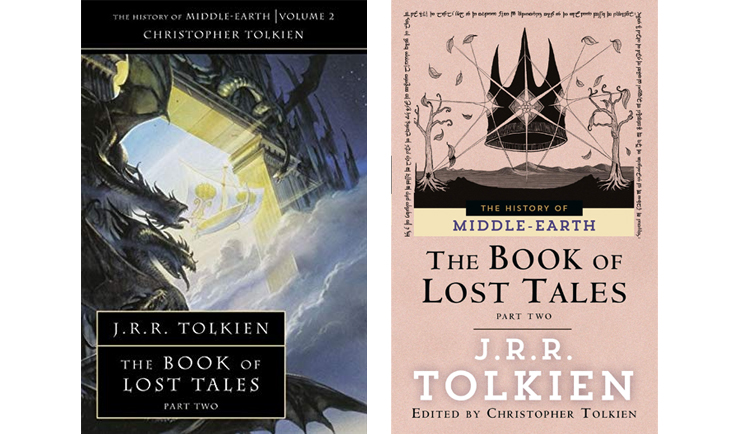
Volume 2: The Book of Lost Tales, Part Two (1984)
The multifarious fragments in this book include the early versions of the Tale of Tinúviel (i.e. Beren and Lúthien), Túrin Turambar, the Fall of Gondolin, the Nauglafring (what will later be Nauglamír), and the crazy Sinbad-like journeys of Eärendel the mariner. But the big question is: is there any dirt on Orcs in all these unpolished tales? There sure is!
At first, in “The Tale of Tinúviel,” we just get that goblins and Orcs are “foul broodlings of Melko who fared abroad doing his evil work,” with no talk of their beginnings. They don’t sound especially fearsome, but it’s no surprise: In this version, Beren himself is no mortal but one of the Noldoli (Gnomes) and everything is a few notches closer to fairy tales in the contemporary fashion. Moreover, when he is captured by Orcs, Beren is brought before Melko directly (!) and the latter punishes him by giving him over to Tevildo, Prince of Cats, where he is made to serve in the kitty-lord’s kitchens. That’s right, the great force of evil in the world condemns the hero to scullery work for a big kitty. So this isn’t really the best place to look for Orc origins. Remember, this was written before even The Hobbit.
For something more concrete, we must flip to Tuor’s tale in “The Fall of Gondolin.” Just when he’s reached Gondolin, the hidden city of the Noldoli, a comparison is made between him and the Elves who gather around him, marveling at the man’s rugged appearance. He is tall among Men, while they are small and slender, exiles among Elves “haunted” by their desire to return to Valinor. Meanwhile, we learn that many other Noldoli outside of Gondolin have become thralls to Melko and are said to be “bent of back” by hard labor in his mines. Tolkien then gives us this “sidebar” of extremely interesting lore, which is probably his first stab at Orc identity.
How it came ever that among Men the Noldoli have been confused with the Orcs who are Melko’s goblins, I know not, unless it be that certain of the Noldoli were twisted to the evil of Melko and mingled among these Orcs, for all that race were bred by Melko of the subterranean heats and slime. Their hearts were of granite and their bodies deformed; foul their faces which smiled not, but their laugh that of the clash of metal, and to nothing were they more fain than to aid in the basest of the purposes of Melko.
Thus, Orcs here are manufactured from the “heats and slime” of Melko’s subterranean domain, not exactly made from the sugar and spice and everything nice of Elvish repute. Yet we also have the first suggestion that some of the captive Noldoli may have been “twisted” to evil and “mingled” with the selfsame Orcs to produce a kind of hybrid that blurred the lines between them—at least to other Elves. In his explanatory text, Christopher Tolkien makes the point that this is “quite distinct from the idea that the Orcs were actually bred from Elves,” which comes much later. Far off is his father’s conviction that Melko(r) cannot make living things of his own.
Buy the Book
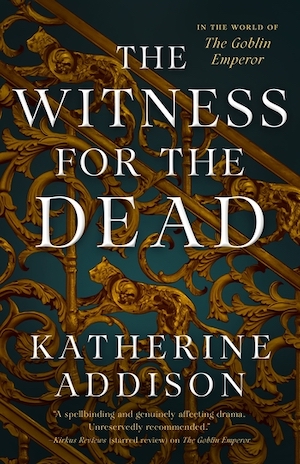

The Witness for the Dead
Ah, but we do first see the Elves’ name for Orcs: Glamhoth, which at this point is translated to mean “folk of dreadful hate.”
Fast forward again to the birth of Eärendel (later to be spelled Eärendil), which is a pivotal moment in history, and even though Melko doesn’t yet pay much attention to mortals, something he can’t quite understand worries him. So he sends out a great army of spies and “sons of the Orcs” to find the source. The latter come with no explanation, only a description, for they had “eyes of yellow and green like cats that could pierce all glooms and see through mist or fog or night.” These feel like another form of hybrid, and it may be that Melko doesn’t want to send out his full-blooded Orcs?
In the siege of Gondolin itself—a zanier but fascinating early version of this epic battle that includes dragonlike metal constructs and hundreds of Balrogs—we get the names of four particular Orcs. They’re not famous, just part of a heroic moment Tolkien zooms in on, which is why they’re promptly dispatched and never heard from again. But I appreciate the reminder that Orcs aren’t mere drones. Someone named these guys and raised them, and then an axe-wielding Tuor and a sword-wielding Ecthelion did them in. Sadly, Tolkien gives us no time to get to know them.
So in memoriam, in the style of The Gashlycrumb Tinies (with all due apologies to both Edward Gorey and J.R.R. Tolkien):
O is for Othrod, head cloven in two
B is for Balcmeg, asunder was hewed
L is for Lug, his legs lost at the knee
O is also for Orcobal, ‘we hardly knew ye’
That last one is the Orcs’ “chiefest champion,” and yet his slayer, the Elf-captain Ecthelion, is still more famous for bringing down Gothmog, the Lord of Balrogs. Tolkien is surprisingly visceral in this text, such that we learn more about these Orcs’ mortal blows than about the Orcs themselves. Orcobal, for example, has his head “cleft” to his teeth. Yikes.
But we’re also told, concerning Orcs…
Tis said that Ecthelion’s folk there slew more of the goblins than fell ever in all the battles of the Eldalië with that race, and that his name is a terror among them to this latest day, and a warcry to the Eldar.
Here it’s implied that more Orcs died in the siege of Gondolin than anywhere else… combined? Tolkien, Lord of Superlatives! Given that Ecthelion is himself slain by Gothmog, it’s quite impressive that his name still becomes a warcry ever afterwards among Elves. It also implies that Orcs who did survive Gondolin kept the Elf’s name alive as a “terror.” There are surely no Orc-poets but they do presumably maintain some kind of battle-based oral tradition.
In “The Nauglafring,” the tale that in The Silmarillion would become “Of the Ruin of Doriath,” when the Dwarves turn their wrath upon the Elf-king Tinwelint (later to be named Thingol), they do so alongside Orc mercenaries. Whaaaa? Indeed, the Dwarf-king of Nogrod is a real villain here, ensnared by the cursed gold of Glorund (Glaurung) as even some Elves are. Speaking of the Dwarf-king…
Moreover he gathered about him a great host of the Orcs, and wandering goblins, promising them a good wage, and the pleasure of their Master moreover, and a rich booty at the end; and all these he armed with his own weapons.
In The Silmarillion, Morgoth can just laugh at this Elf-vs-Dwarf war taking place without any direct intervention on his part, but in this earlier conception, he allows his Orcs to get roped into it for pay. In his commentary, Christopher Tolkien calls this idea “incredible and impossible later,” given the direction his father later went with Dwarves. Thankfully.
But now it’s time to wax poetic in…
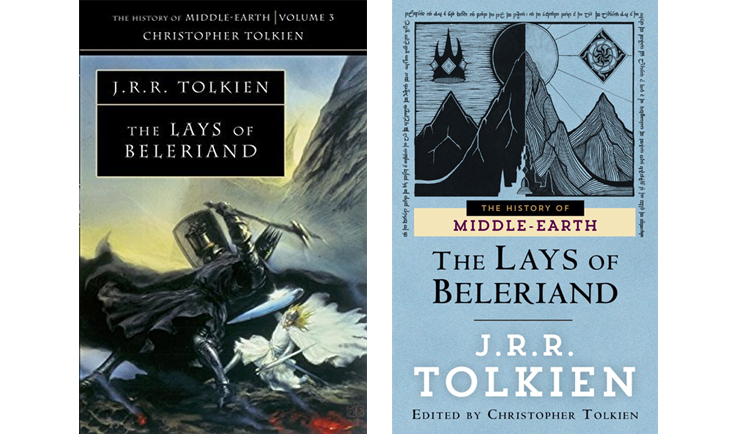
Volume 3: The Lays of Beleriand (1985)
There are Orcs aplenty in this book of narrative poems (or lays), and given the wordsmith that Tolkien was, they never sounded so good. Or terrible. While there is no further insight into the real identity of Orcs, scads of adjectives are ascribed to them in the verse that does further flesh them out. They are called ruthless, hungry, gloating. Their “deep eyes drill the darkest shadows.” The sound of their marching is a “drumming of hideous stamping feet,” their laughter is “like clash of stone and steel,” their hooting voices “now wafting high, now wavering far.” Noise and clamor accompany their presence. Every now and again, some other variety of monster is dropped in alongside them—like ogres, again. With no details given, those might as well just be an early take on trolls.
But I’d like to zoom in on one of the cantos of The Lay of Leithian, which The Silmarillion glosses over without detail. Felagund (Finrod Felagund, for those who know the published Silmarillion) and ten of his loyal subjects join Beren, setting out on the mortal’s quest to claim a Silmaril from the crown Morgoth wears—which he is doing to win the approval of Lúthien’s father). Our heroes stalk a band of thirty Orcs then wait until they’ve camped before attacking swiftly in the night, killing them all. This is when Felagund uses his skills—equal parts practical and magical—so that the twelve of them can approach Angband in the guise of Orcs. This gives us a better image of Orcs’ appearance and trappings, at least at this point in time. Felagund uses pigments on their skin and cuts actual hair from goblin heads to set as wigs upon them. It disgusts them, but it’s important.
Then Felagund a spell did sing
of changing and of shifting shape;
their ears grew hideous, and agape
their mouths did start, and like a fang
each tooth became, as slow he sang.
Their Gnomish raiment then they hid,
and one by one behind him slid,
behind a foul and goblin thing
that once was elven-fair and king.
In The Silmarillion, the Sindar Elves first mistake Orcs for some sort of savage Avari (those Elves who never started on the journey towards Valinor), with whom they’ve become estranged. Yet here a dramatic transformation of makeup and magic is required to make Beren and eleven Elves appear as Orcs. This again raises the question Tolkien never expressly answers: In what ways did Orcs get confused with Avari Elves only a few centuries before? Or don’t they resemble them in any way (anymore)? Have all elvish features been bred out?
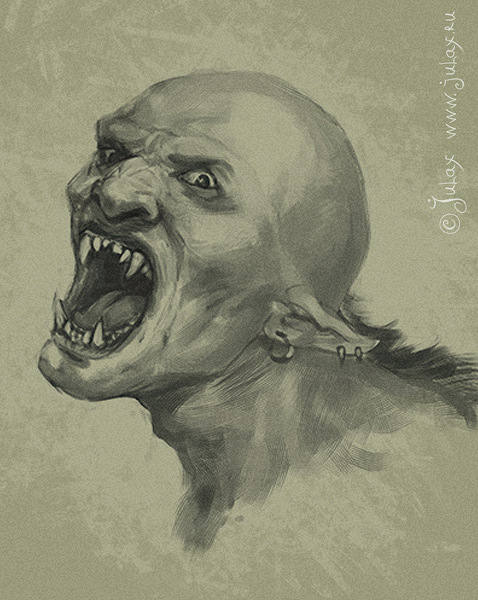
In any case, it’s dangerous for Beren and company to proceed like this, because they number only twelve, yet “never alone to war so small an Orc-band went, they knew.” It’s suspicious to traipse about in so small a band!
Their disguises hold up for a time, fooling plenty of actual Orcs—look, they’re wearing “Angband’s raiment foul” and they carry the “poisoned spears,” “bows of horn,” and “crooked swords” like all Orcs do. But on their road toward Angband, they have to pass by the tower of Thû (the next incarnation of proto-Sauron). The fact that they don’t stop there for debriefing is the red flag that prompts the dreadful necromancer to summon them. They are skating on thin ice now, surrounded by wolves and werewolves and scrutinized by “Morgoth’s mightiest lord” himself, master of “foul enchantments and dark sigaldry” (a.k.a sorcery). When Thû demands their names, Beren and Felagund give the Orc-aliases they’re going with: Nereb and Dungalef. (Presumably, they knew some Orc-names and didn’t just come up with these on the fly. Elves are good with names.)
Thû interrogates them, and they know a little too much for roving Orcs. More red flags. They also claim they were on their way to report to an Orc-captain named Boldog, but Thû calls them out: Isn’t Boldog dead? Like, recently, and in fact slain at the edge of the realm of Doriath on an errand to capture the Elf-king’s fair daughter, Lúthien? After all, Thû says, Morgoth sure would like to “possess her in his lair.” Well, Beren… err, I mean Nereb… sure doesn’t like hearing that, and his reaction pushes Thû further on offensive. He demands that they, as so-called “Orcs of Bauglir,” repeat their vows. Bauglir, in this context, is another epithet for Morgoth, meaning “the Constrainer.”
So in this version, Orcs take vows! A curious idea that raises questions about their upbringing. It’s as if Morgoth demands they put their malice where their mouth is, or that he knows the value of pledges in Arda. Thû then cites (or paraphrases?) a portion of just such a vow, as if quoting from some Angband handbook of evil:
‘Death to light, to law, to love!
Cursed be moon and stars above!
May darkness everlasting old
that waits outside in surges cold
drown Manwë, Varda, and the sun!
May all in hatred be begun,
and all in evil ended be,
in the moaning of the endless Sea!’
Can you imagine Orcs in The Lord of the Rings even speaking such organized verse? But this was another time, with different Orcs, and then again, this is a narrative poem, where even Orcs put some rhyme and meter in their speech. Now, Beren and the Elves, being definitely not Orcs, can’t stomach this talk; it’s blasphemy, and their reticence lands them in Thû’s dungeons.
Incidentally, Boldog is mentioned a few other times. He is “a captain dire,” but like so many other villainous subordinates, his name is given along with news of his death. Elsewhere in Christopher’s notes we’re told that King Thingol himself is the slayer of Boldog, who was indeed sent by Morgoth to the borders of Doriath in search of Lúthien specifically. But not because Morgoth had any idea she and Beren were coming for him; rather, he did so for “no more than the legend of her beauty.” But let’s remember Boldog for later.
Orcs in these early writings seem to possess more defiance of their masters, more agency. Of the battle Fingolfin has with Morgoth outside the doors of Angband, which is witnessed by many of the Dark Lord’s minions, we get this:
Yet Orcs would after laughing tell
of the duel at the gates of hell
Laughing because Morgoth is wounded by Fingolfin seven times, and even gives their master a limp forever with a stab in the heel. Yet in The Silmarillion, we’re told, quite contrarily, that “The Orcs made no boast of that duel at the gate.” It leaves me wondering: Are Orcs later in Tolkien’s thought simply given less humor, or do they simply risk no defiance to Morgoth, even behind his back?
Meanwhile, there’s more about Orc irreverence in…
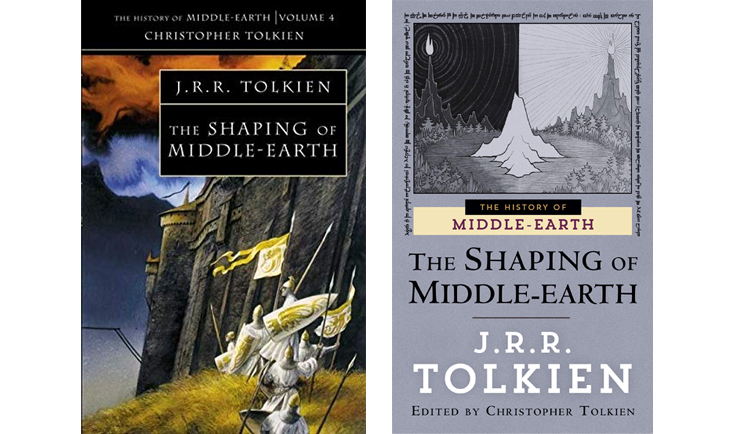
Volume 4: The Shaping of Middle-earth (1986)
This book begins the transitions between Tolkien’s Book of Lost Tales and The Silmarillion, with a focus on maps and geography and, as always, some bits and bobs of Middle-earth verse.
In the “Sketch of the Mythology,” a very fascinating claim stands out in Tolkien’s notes concerning Tuor and the fall of Gondolin. The Vala named Ylmir (the Gnomish name for Ulmo) gives the mortal Tuor a very important mission: to request that Turgon, the Elf-king of Gondolin, go out and challenge Morgoth with the force of war. If Turgon does this, Ulmo himself will then convince the other Valar to send aid in this great battle. It will be a costly war “but the race of Orcs will perish and will not in after ages trouble Elves and Men.” Bold claim! All the Orcs would be wiped out?! Now, this remarkable claim does not survive in The Silmarillion, and it’s not like Turgon was ever going to listen. He’ll wait until the last minute, as he always does in every version of the tale, like a character caught in some Groundhog Day cycle, and Gondolin will always fall.
Later, in the Quenta, we get another spin on Orc origins that actually precedes the awakening of the Elves. The text describes Morgoth’s settling into the North of Middle-earth after he’s thrown down the Lamps of the Valar. Then:
The hordes of the Orcs he made of stone, but their hearts of hatred. Glamhoth, people of hate, the Gnomes have called them. Goblins may they be called, but in ancient days they were strong and cruel and fell. Thus he held sway.
Here they have no connection to Elves or Men. He made them from whole cloth, as it were, from the earth. Varda eventually kindles the stars in the heavens and then the Elves arise. This early on, Tolkien wasn’t troubled by questions of Orcish souls or their long-term fate.
Now, about that Orc irreverence, let’s jump to this book’s story of Beren, Lúthien, and their famous jewel heist. The mortal Man and his immortal girlfriend have made their way into Angband in monstrous disguises. They get past the dreadful guardian at the doors and proceed down into the depths. Before the throne of Morgoth, Beren “slinks” in his wolf-shape, while Lúthien pretends to be a captive brought in by the wolves of Thû.
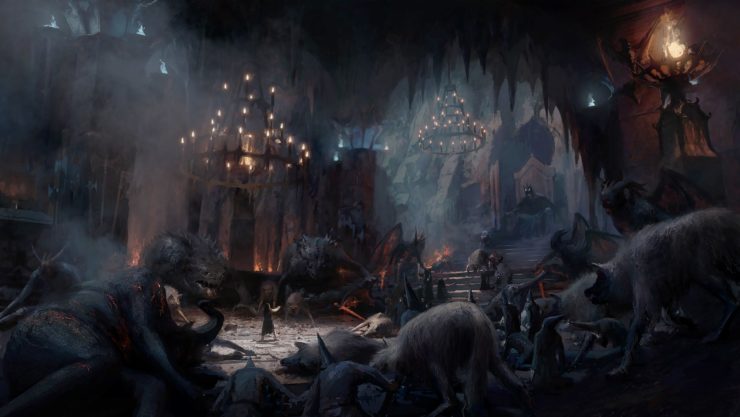
Lúthien gives her true identity, shedding her bat-winged “evil fay” disguise.
And she beguiled Morgoth, even as his heart plotted foul evil within him; and she danced before him, and cast all his court in sleep; and she sang to him, and she flung the magic robe she had woven in Doriath in his face, and she set a binding dream upon him—what song can sing the marvel of that deed, or the wrath and humiliation of Morgoth, for even the Orcs laugh in secret when they remember it, telling how Morgoth fell from his chair and his iron crown rolled upon the floor.
And this is the moment I always think of when I read in The Silmarillion that Orcs, though they serve him, still hate Morgoth, “the maker only of their misery.” I wonder only if laughing “in secret” means it is an entirely private affair, or if one to another a chuckle is shared? This seems a very human thing to do, to find secret pleasure when someone you do not like is humbled. In this case, it’s the body of their big scary boss, tumbling from his throne onto the floor like a doofus. Of course, in this early writing, Orcs have been made by Morgoth entirely and are not simply twisted Elves.
Which makes sense, given what Tolkien says about Orc-speech in…
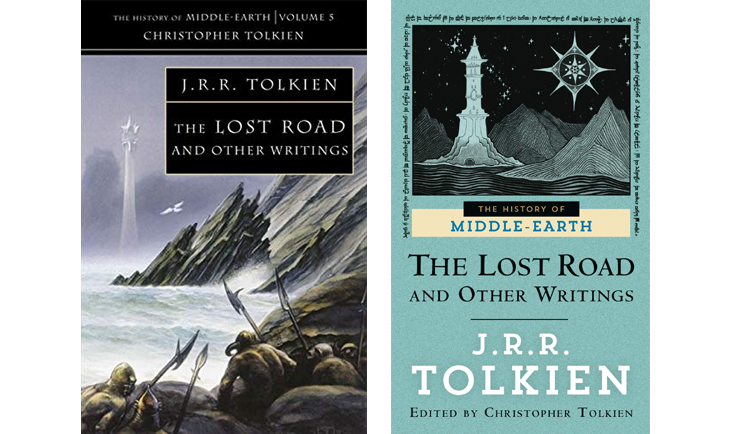
Volume 5: The Lost Road and Other Writings (1987)
This book offers still more drafts and essays of the early legendarium, including the genesis of the Downfall of Númenor, with a strong emphasis on language—you know, that aspect of Tolkien’s world that was paramount to him.
In one iteration, the Elves don’t invent their own speech but learn it from the Vala who first discovers them: Oromë the Lord of Forest. Of course, they modify and “soften its sounds” to their own tastes. So why do I mention Elves first? Because one recurring motif with Tolkien—no matter the Orcs’ origin—is that they’re always Morgoth’s foil to Elves and/or Men. Whether made in “mockery of the creatures of Ilúvatar” or fabricated from the stones of the earth before he’s even laid eyes on the Elves, Orcs are always Morgoth’s take on the very people Arda was made for. They’re the anti–Children of Ilúvatar.
Curiously, in this early version, Orcs, too, get their own language.
Of other tongues than the Oromian speeches, which have yet some relationship therewith, little will here be said. Orquin, or Orquian, the language of the Orcs, the soldiers and creatures of Morgoth, was partly itself of Valian origin, for it was derived from the Vala Morgoth. But the speech which he taught he perverted wilfully to evil, as he did all things, and the language of the Orcs was hideous and foul and utterly unlike the languages of the Qendi. But Morgoth himself spoke all tongues with power and beauty, when so he wished.
Contrast this to what Tolkien writes of Orc-speech in Appendix F of The Lord of the Rings, just before explaining that Sauron tried to get them to learn Black Speech—but it wouldn’t quite take.
The Orcs were first bred by the Dark Power of the North in the Elder Days. It is said that they had no language of their own, but took what they could of other tongues and perverted it to their own liking; yet they made only brutal jargons, scarcely sufficient even for their own needs, unless it were for curses and abuse. And these creatures, being filled with malice, hating even their own kind, quickly developed as many barbarous dialects as there were groups or settlements of their race, so that their Orkish speech was of little use to them in intercourse between different tribes.
That’s a low opinion indeed for any people, given that the author was a master philologist. Orcs, he decided, couldn’t even work up their own language properly. This also explains why Orcs of the Third Age use the Common Speech of Westron, if not especially well. Either way, the message is the same: wherever they get their language from, the Orcs foul it up and only make creative use of the “curses and abuse.”
There’s one curious rejected phrase that Christopher cites from one version of the fall of Fingolfin at Morgoth’s hand. Before the doors of Angband their battle is fought, and though the Elf-king is defeated he manages to wound Morgoth once. And…
The Orcs sing of that duel at the gates
Can you imagine Orcs in the War of the Ring singing? Now, this quote does come from verse, so maybe “sing” isn’t literal but meaning “told the tale,” but I’m not so sure. This early in their development, Orcs had their own language, so it’s not so crazy. Moreover, the goblins of The Hobbit certainly had their own songs. (And only in our headcanons may we count the disco-laced “Where There’s a Whip There’s a Way.”)
Speaking of the War of the Ring, we come to…

Volumes 6–9: The History of The Lord of the Rings (1988-1992)
Not a deep dive here, as these four books—The Return of the Shadow, The Treason of Isengard, The War of the Ring, and Sauron Defeated—focus solely on the early drafts of The Lord of the Rings itself and do not provide very distinctive clues about Orc nature or language. There are some fun little details, like the names of some Orc-captains in Mordor that Tolkien waffled around with: Gazmog, Zaglun, Yagul, Uftak, or, as Christopher describes it, the “double-barrelled Orc-name Naglur-Danlo.”
Really take that in. Naglur-Danlo. Danlo the Orc.
Then there’s that delightful epilogue in Sauron Defeated (sometimes titled The End of the Third Age), that Tolkien opted not to include in LotR, in which Sam’s children ask him questions about the aftermath of his adventurers. His son Frodo asks if there are any Orcs left, and Sam says, “I daresay there are if you know where to look,” but when Elanor asks about Moria and Orcs, he says:
‘Moria: I have heard no news. Maybe the foretelling about Durin is not for our time. Dark places still need a lot of cleaning up. I guess it will take a lot of trouble and daring deeds yet to root out the evil creatures from the halls of Moria. For there are certainly plenty of Orcs left in such places. It is not likely that we shall ever get quite rid of them.’
This is in some contrast to the “The Field of Cormallen,” which suggested a surer end to Orcs. But then, this epilogue was left off in the end. In any case, it’s time to jump forward to…
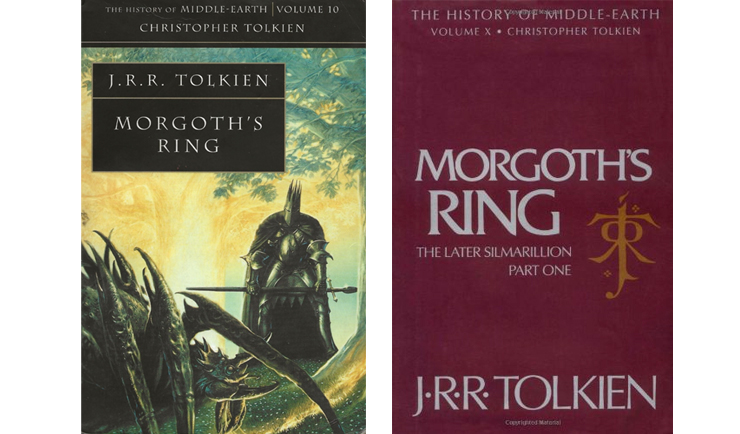
Volume 10: Morgoth’s Ring (1993)
In my opinion, this is the crème de la crème—the jewel in the crown, if you will—of the whole series. For one, much of this Silmarillion-esque lore was written post-Rings and was informed by it. Among other gems, the book contains chronologies of ancient Arda; the “Laws and Customs among the Eldar,” the go-to source for Elf-culture; and a storied First Age conversation between the coolest Elf ever and the most astute of mortal women. We are also introduced to the concepts of fëar (analogous to the spirit) and hröar (analogous to the body), which are important when discussing incarnate thinking creatures in Tolkien’s legendarium, like Elves, Men, Dwarves… and maybe Orcs. But most directly relevant to our discussion, Christopher Tolkien shares some essays his father wrote specifically about the problem of Orcs, and it’s important to note that The Lord of the Rings was behind him at this point.
But let’s start with “The Annals of Aman,” a thorough chronology of the ancient days, where we are reminded about the mutual contempt between Orcs and Melkor/Morgoth.
In form they were like unto the Children of Ilúvatar, yet foul to look upon; for they were bred in hatred, and with hatred they were filled; and he loathed the things that he had wrought, and with loathing they served him.
We’re a long way away from the “heats and slimes” days of Tolkien’s thought, but Orcs have never stopped being abominable in appearance. Then, that theme of noise is brought back in.
Their voices were as the clashing of stones, and they laughed not save only at torment and cruel deeds. The Glamhoth, host of tumult, the Noldor called them. (Orcs we may name them; for in days of old they were strong and fell as demons. Yet they were not of demon kind, but children of earth corrupted by Morgoth, and they could be slain or destroyed by the valiant with weapons of war.)
This isn’t especially new, but here is further mention that the Glamhoth were stronger in these ancient days. The Elves claim that “in their beginnings” Orcs were Quendi enslaved, and maybe that’s one reason why they were greater. Like most things in Arda, they fade over time, at least in body, in hröa; even whole peoples. Tolkien also drops the following axiom about Melkor:
Melkor could never since the Ainulindalë make of his own aught that had life or the semblance of life, and still less might he do so after his treachery in Valinor and the fullness of his own corruption.
Aught means anything. So Tolkien is very firm at this point—as he was when writing The Lord of the Rings—that evil should not be able create any kind of life of its own. Not only could Morgoth not do so even at the time of the Music of the Ainur (that is, before time and the universe were even things), he could do even less after his enacting his triptych of evil deeds in Valinor following his release from the Halls of Mandos: (1) the killing of Finwë (the High King of the Noldor), (2) the theft of the Silmarils, and (3) the destroying the Two Trees with his spider gal pal, Ungoliant.

In a previous article, I explored more thoroughly this idea that in marring the world and corrupting so many of its creatures, Melkor diminished his own being. And now, this reminder of Melkor’s merit-based demotion makes me wonder: Had he not bred the Orcs when he did—that is, before his defeat in Utumno and subsequent incarceration in the “fastness of Mandos”—would he even have had the strength to do so when returning to Middle-earth ages later? When he settles down in Angband, post-Valinor, he’s really just picking up where he’d left off, doubling down with his nihilistic aims. The Orcs were already there for his reclamation. Just a thought.
It’s in the chapter “Myths Transformed” that Tolkien finally wrestles with the conundrum of Orcs directly, though it must be understood that even Christopher calls this section a “reinterpretation” of his already published work.
Let’s start with the high-level theology of the matter: Only Eru, Ilúvatar (God), can create creatures of independence, creatures of free will. Since Orcs sometimes grumble about or try to defy their Dark Lord, they must be corruptions of something pre-existing, something that did have the independence granted by Ilúvatar. Yet when Orcs were “made,” Men hadn’t showed up yet, so it can’t be them, right? Has to be Elves.
Let’s look to the work of Aulë, the smith-Vala who made the Dwarves when he was getting antsy for the arrival of Elves and Men. Ilúvatar scolded Aulë for this but he did imbue the Dwarves with precisely the sort of independence that Elves and Men all receive. No way would Ilúvatar do the same for Orcs, Tolkien reasons… unless Ilúvatar allowed Orc-souls to be “ultimately remediable.” Such a thing would be achievable, in theory, in the rehab center that is the Halls of Mandos (where Elves’ fëar are summoned when their bodies are slain). If this were possible, even though in life they are thoroughly dominated by Morgoth, Orcs could still possess that independent will (whomever they were made from).
On the other hand, if Orcs are a species created by Melkor, then there’d be no moral problem associated with them. Eradicating them would be just, for they’d be mere extensions of himself. Puppets. Soulless constructs of evil with no true wills of their own. But after his Book of Lost Tales years, Tolkien wasn’t satisfied with this idea. It didn’t sit right. He could not abide Melkor creating anything of his own. Melkor hates and seeks to destroy all that does not proceed from himself—meaning the entirety of Arda, all his monsters, and even the Orcs.
And this fits with the thinking of the Roman senator/philosopher Boethius. Most notably, Tolkien scholar Tom Shippey cites the Boethian view as active throughout The Lord of the Rings. In his book J.R.R. Tolkien: Author of the Century, Shippey describes the basic concept as “there is no such thing as evil. What people identify as evil is only the absence of good.” Thus, the very existence of Orcs is not evil’s own thing, merely the absence—or indeed, the exploitation—of what was at first good. Just as we have seen Frodo tell Sam that the Shadow can mock but cannot make.
But again: If evil is powerless to create its own soldiers, and Orcs are somehow corrupted Children, why is it okay to eradicate them?…Is it okay?
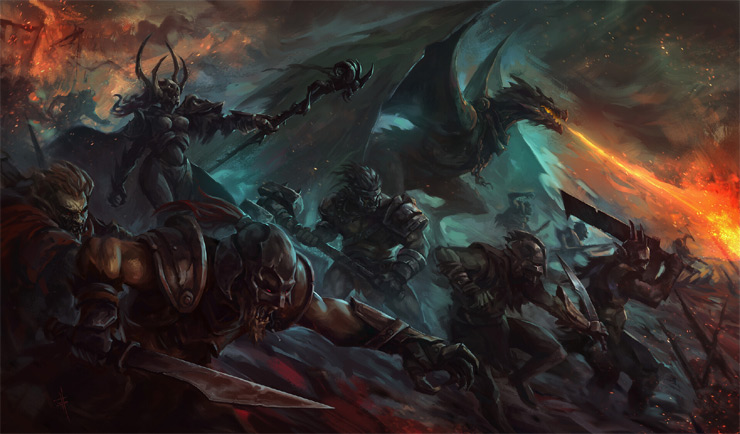
Well, given these conflicting ideas concerning Orcs, Tolkien tosses some potential solutions at the legendarium wall, to see if anything sticks. Solutions like…
Orc bodies inhabited by Maiar: Maiar are those “other spirits whose being also began before the World”—like Gandalf, Saruman, Sauron, and all the Balrogs—and who are generally lesser in power than the Valar. We’re told that many of the Maiar “were drawn to” and corrupted by Melkor. So this solution implies that such spirits infused the Orcs that Melkor formed from the earth. Granted, they’d be the least of such beings, weak for Maiar but powerful for creatures made in the image of the Children. This would be a good fit, maybe, for those Orcs of the Elder Days that we were told “were strong and fell as demons.” In this scenario, they are demons in mortal flesh.
Moreover, following the metaphysical laws of Tolkien’s world, Maiar inhabiting physical shapes become even more “earthbound” when procreating (as does Melian, mother of Lúthien). But being evil, when they are slain such Orcs would become—like Sauron eventually—“damned.” That is, still existing but unable to influence the physical world much, if at all. As always, Tolkien’s footnotes and parentheticals are the most fun: “(or would not a very dwindled dead Orc-state be a poltergeist?)”
I am greatly amused at the thought of an apparition rearranging furniture in someone’s house in modern times having once been Shagrat the Orc-captain of Mordor.
Orcs are a kind of talking beast: This time they’re not independent people at all. In which case, there’d be no concern about the fate of their fëar (spirits) since they essentially have none; they have no choice in what they’re doing. Tolkien asserts “that ‘talking’ is not necessarily the sign of the possession of a ‘rational soul’” and that Orcs could just be beasts worked into a “humanized shape (to mock Men and Elves)” yet made to look more like Men. Their speech would just be the rotation of “‘records’ set in them by Melkor,” more like parrots given a set vocabulary. In this variation, the independence that Orcs sometimes exhibit is likened to the sort of rebellion a dog or horse may have against their human master.
If Orcs are not wholly beasts, beasts might still be in the mix somehow. Tolkien wrote:
It remains therefore terribly possible there was an Elvish strain in the Orcs. These may then even have been mated with beasts (sterile!)—and later Men. Their life-span would be diminished. And dying they would go to Mandos and be held in prison till the End.
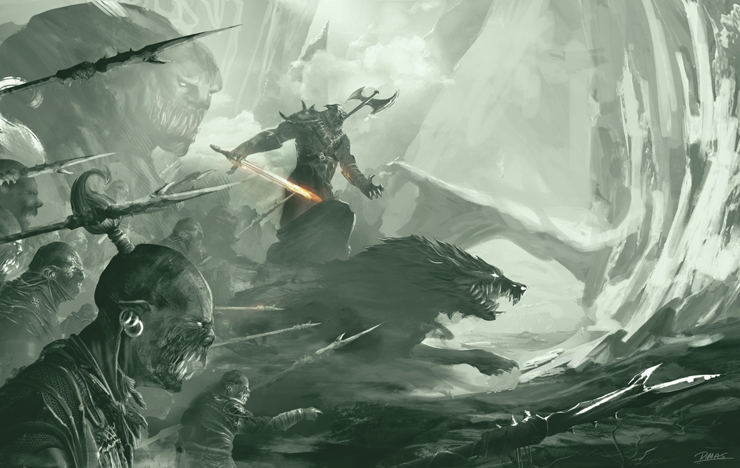
Now, Orcs could still lack the spirits of the Children of Ilúvatar (be they Elves or Men) and yet show rebellious traits. Tolkien reasons that the will put into them is simply Morgoth’s own, or rather part of his own power “dispersed.” Being spirits of hate, they hate even their own maker. Evil is “non-cooperative (except under direct fear),” and fear is precisely what motivates the Orcs—that much has never changed. And when Morgoth is deposed and Sauron takes over, they only serve him when he’s active or powerful enough to govern them.
Still, nothing Tolkien brainstorms here can quite reconcile the conflicting theological assertions from The Lord of the Rings:
- Evil is unable to create beings with independent wills of their own. It can only corrupt existing ones. (Implying that Orcs cannot be soulless constructs.)
- It’s totally okay to kill Orcs. (Implying they have no remediable spirits to be concerned with.)
And if they’re Children of Ilúvatar in foundation, he never quite settles on a singular race of origin, seeming to regard them as pretty well mixed by the Third Age. It’s not just which of the incarnate creatures they were bred with that’s up in the air, but what inhabited them.
Most of them plainly (and biologically) were corruptions of Elves (and probably later also of Men). But always among them (as special servants and spies of Melkor, and as leaders) there must have been numerous corrupted minor spirits who assumed similar bodily shapes. (These would exhibit terrifying and demonic characters.)
He seems to come back to this idea that even if Orcs aren’t demonic in origin, there must have been some that were evil-spirits-in-Orc’s-flesh. A footnote even names the aforementioned Boldog as one of these “Orc-formed Maiar,” though Christopher adds that Boldog may not be the personal name of an Orc but a title or a kind “only less formidable than the Balrogs.” Which is nothing to sneeze at!
Thus it was that the histories speak of Great Orcs or Orc-captains who were not slain, and who reappeared in battle through years far longer than the span of the lives of Men.
Does history speak of them, Tolkien?! Where? I’d very like to read more!
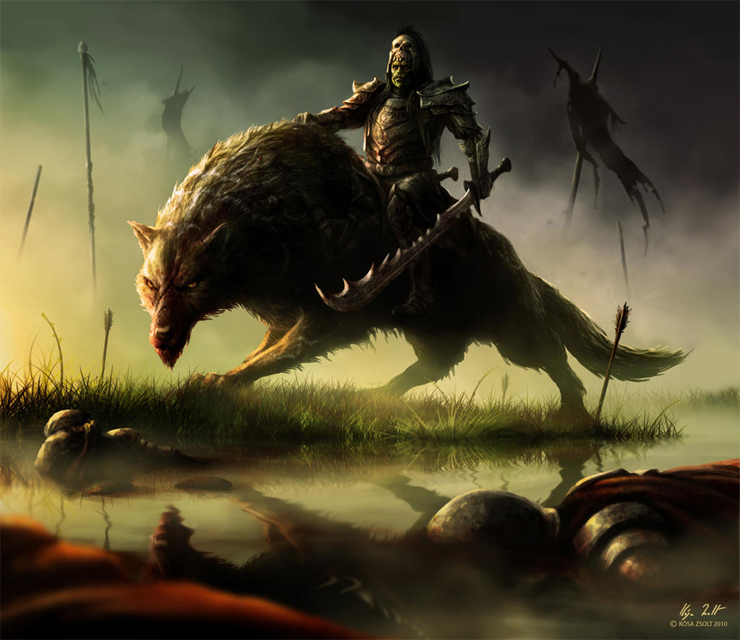
Tolkien banishes the idea that any Orc-formed Maiar would be present during Sauron’s tenure as Dark Lord. They were a First Age problem. No spirits or phantoms numbered among the Orc-armies of Mordor, not even those scary and “grim servants of Barad-dûr” we read about in Unfinished Tales, under whose orders the Orcs at the Gladden Fields took down Isildur. If anything, these latter-day Orcs are less powerful but more refined. Tolkien writes that they were…
living creatures, capable of speech and some crafts and organization; or at least capable of learning these things from higher creatures and from their Master. They bred and multiplied rapidly, whenever left undisturbed.
Here it seems that even without a Dark Lord’s stewardship, Orc mojo was just fine and they propagated plenty. But did they have the drive to go invading the realms of Men and Elves on their own? From what we learned in The Lord of the Rings and Unfinished Tales, no, not really.
While Tolkien never comes to a final conclusion on this subject, he does seem to settle on a few truths. Orcs are capable of doing evil independently “for their own sport,” and if their Master is far away, yeah, they might just slack off. They’re mortal, they can get sick, and they’re short-lived even compared to Men. And even if mortal blood wasn’t part of the recipe in the beginning, the blood of Men likely found its way into the breeding program even before Morgoth’s dishonorable discharge from Arda. Men under his dominion could “in a few generations” be reduced “almost to the Orc-level of mind and habits” and be “made to mate with Orcs, producing new breeds, often larger and more cunning.”
And of course we know that in the Third Age, introducing Mannish blood is precisely what Saruman revisits in Isengard. Saruman’s treachery is downplayed; he is such a bastard for doing what he does with Orcs and Men. Even here in Morgoth’s Ring, years after LotR’s publication, Tolkien calls it out directly, saying it was “Saruman’s wickedest deed.” You get the sense he’d have made a bigger deal of it in the book if he could go back. Mr. Retconner over here.
But back to Morgoth: “Myths Transformed” insists that Orcs are so dominated by him that if he actively directed his thoughts upon them, “they were conscious of his ‘eye’ wherever they might be.” And yet: Remember that link between the Orcs and their Dark Lord, which I discussed in my orcs-of-LotR article? That is, that “servitude to a central will” that renders them insect-like and “purposeless” when it was taken away (as seen after the destruction of the One Ring)? Now we get that Orcs did experience this before, after Morgoth’s removal. And they even “recovered” from it. Hence, when Sauron rises as the new Dark Lord, he has to do a lot more work to organize them—because they’d settled into separate cultures, breeds, and languages without any direct involvement. They’d even scattered to mountains across Middle-earth. Thus, before Morgoth’s great defeat, you could say they were more homogenized; there were no Great Goblins or Orc-kings feuding with one another. Tolkien points out that Sauron actually does a better job establishing “greater control” over Orcs, even though they were weaker in latter days than they once been. Like everything in Arda.

And it makes sense that Sauron’s the better Orc-boss. Cooking up Orcs may have been Morgoth’s big win, but when he first conceived the idea, his purpose was the “defilement of the Children and the blasphemous mockery of the designs of Eru.” He didn’t do it to create an army. Not at first. But if his efforts yielded him some soldiers… well, winner winner glamhoth dinner! The particulars of Orc management was left to Sauron, we now learn. And this is precisely the stuff left out of The Silmarillion that I wish had made the cut:
When Melkor was made captive, Sauron escaped and lay hid in Middle-earth; and it can in this way be understood how the breeding of the Orcs (no doubt already begun) went on with increasing speed during the age when the Noldor dwelt in Aman; so that when they returned to Middle-earth they found it already infested with this plague, to the torment of all that dwelt there, Elves or Men or Dwarves.
While it remains unclear what Orcs are, Elves and Men still considered them existing “within the Law” (big L). Yes, they “might have become irredeemable,” and “must be fought with the utmost severity,” but they should not be treated with the kind of cruelty Orcs themselves exhibited. That means no torture, not even to extract information that would help defend their homes from Orcs’ plans. Mercy must be granted, if an Orc captive asks for it. (Which we certainly never see happen anyway.) But then there’s this sampling of villain psychology which I’ve seen nowhere else. In the Elder Days…
at no time would any Orc treat with any Elf. For one thing Morgoth had achieved was to convince the Orcs beyond refutation that the Elves were crueller than themselves, taking captives only for ‘amusement’, or to eat them (as the Orcs would do at need).
For one thing, Morgoth convinced them of this? So while he inspires overwhelming fear and hate in Orcs, he cannot simply choose their thoughts for them. This statement certainly scores points for the Orcs-aren’t-constructs argument. It’s as if a steady diet of propaganda is needed to keep Orcs in line, to keep them from conversing with Elves and learning too much. Thus, they’re led to believe that Elves are worse than they are and actually ate captive Orcs?! Whoa. I’d like to point out that the other implication of this passage is that cannibalism is hardly plan A even for Orcs, only “at need.” So meat is only sometimes “back” on the menu.
While it’s true that Tolkien wrote these ideas long after The Lord of the Rings as part of a “reinterpretation of central elements” of his mythology (as Christopher describes it), it’s still easily applied to Snaga’s anxiety in the Tower of Cirith Ungol, worrying about a “great fighter or one of those bloody-handed Elves” who apparently got past the Watchers and is holy crap on the way right now! Orcs went after Men and Dwarves often enough, even on their own, but it seems it takes direct orders from a Dark Lord to get them to go after Elves.
This entire section comes to a close with Christopher pointing out that his father’s final thought about Orcs was that they were bred from Men. Go figure. But this idea was never hashed out in any publishable form other than right here in the HoMe books. It doesn’t square with the chronology or the cosmology—which he was also aiming to rework—but it still wouldn’t have solved the theological conundrum. Tolkien had mired himself in too many conflicting ideas. But for all that, earlier in “Myths Transformed” we can see that Morgoth had it in for the Orcs, anyway. They would never have escaped the annihilation he’d wanted for Arda.
Hence his endeavour always to break wills and subordinate them to or absorb them into his own will and being, before destroying their bodies. This was sheer nihilism, and negation its one ultimate object: Morgoth would no doubt, if he had been victorious, have ultimately destroyed even his own ‘creatures’, such as the Orcs, when they had served his sole purpose in using them: the destruction of Elves and Men.
All this to say, Morgoth’s Ring is such a great book. And that brings us to the last two in the series…
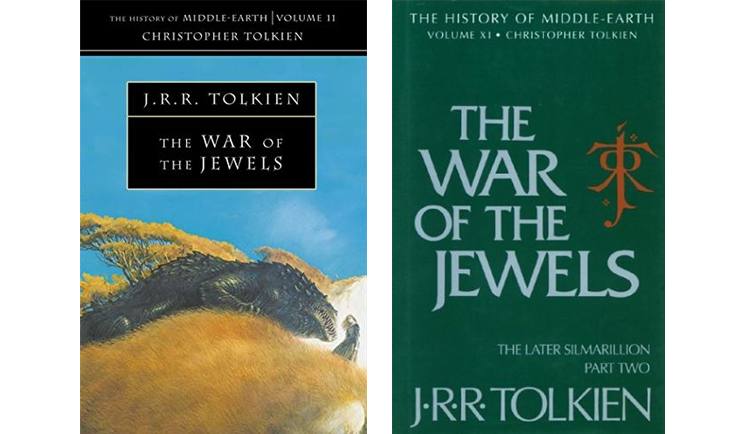
Volume 11: The War of the Jewels (1994)
There isn’t much Orc-lore to write home about in this second post-Rings text, just a few scattered bits that, as always, remind you about details Tolkien could have provided but didn’t. Leaving us to wonder forever.
Like that scene early in the Battle of Unnumbered Tears when the Noldorin Elf Gwindor leads a frenzied charge against Angband’s armies right up to its front doors. We’re told that he and his fellow Elves of Nargothrond “burst through the outer gates and slew the Orcs [even in the very tunnels of Morgoth] within the very fortress of Morgoth.” In the published Silmarillion, the narrative only goes as far as the “very stairs of Angband,” but this additional passage about Elves running down into Orc-tunnels to fight them presents a delightfully savage picture. I can’t help but try and imagine these Orc-tunnels, presumably from which the “ash and slag” was drawn out to erect the peaks of Thangorodrim above.
So, in a hole in the ground there lived… a bunch of Orcs. A nasty, dirty, wet hole, probably.
In the “Quendi and Eldar” chapter, which is all Elvish language and nomenclature (near and dear to the professor’s heart), we get the in-universe origins of the word Orc. There are a startling number of variations and derivatives, of course (because Tolkien), but the chief ancestor appears to be the Quenya word urko (or the Sindarin urug), which was “vague in meaning,” referring “to anything that caused fear to the Elves, any dubious shape or shadow, or prowling creature,” feelings they associated mostly with the early days “before the March.” Which makes sense, given those were the days Melkor found them and started stealing some away with his shadows and evil spirits.
So this word led to Orch (plural Yrch), which “seems at once to have been applied to the Orcs, as soon as they appeared.” It sounds like that feeling of gratification when an author, or comedian, or TED Talk speaker, or… Anglo-Saxon professor puts into words something you’ve felt for a long time but could never articulate. Thus Elves, when they finally encountered Orcs, were like, “YES, finally. That. Urko! Those guys over there. Totally urko (or urug). Good to finally put a (hideous) face to the name.”
We’re told that “[t]he Orcs themselves adopted it, for the fact that it referred to terror and detestation delighted them.” And then we come back to the latter-day meaning of the Sindarin word glam.
Glam meant ‘din, uproar, the confused yelling and bellowing of beasts’, so that Glamhoth in origin meant more or less ‘the Yelling-horde’, with reference to the horrible clamour of the Orcs in battle or when in pursuit—they could be stealthy enough at need. But Glamhoth became so firmly associated with Orcs that Glam alone could be used of any body of Orcs, and a singular form was made from it, glamog. (Compare the name of the sword Glamdring.)
Elves are fun. They provide so many good ways to talk about essentially the same thing, perfect for confusing Men.
Sindarin Elf: Fly! A glam comes. They are too many!
Man: A what?
Sindarin Elf: A glam. More than one glamog.
Man: Come again?
Sindarin Elf: You know, the people of the glamhoth, a host of tumult. A din-horde. Yrchs!
Man: You mean Orcs?
Noldorin Elf: Urko in living flesh.
Man: I’m just going to assume y’all mean goblins. Let’s go.
But Tolkien is never done talking about language, as we see in…
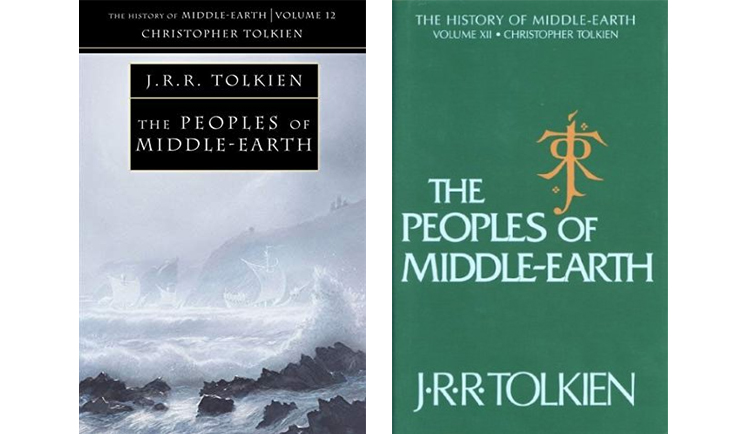
Volume 12: The Peoples of Middle-earth (1996)
Here Christopher Tolkien shares with us “The Appendix on Languages,” which his father had originally wanted combined with the “Concerning Hobbits” prologue of The Lord of the Rings—and immediately confesses he doesn’t know why. Within this agglomeration of linguistic thoughts, Tolkien writes what at first reads like a sick burn on Orcs.
The orcs and goblins had languages of their own, as hideous as all things that they made or used; and since some remnant of good will, and true thought and perception, is required to keep even a base language alive and useful even for base purposes, their tongues were endlessly diversified in form, as they were deadly monotonous in purport, fluent only in the expression of abuse, of hatred and fear. For which reason they and their kind used (and still use) the languages of nobler creatures in such intercourse as they must have between tribe and tribe.
Is it a backhanded compliment to say that all things Orcs made were hideous, but also that there is “some remnant of good will” therein to have kept their language going? But then a bit later he throws some more punches.
The speech of Orcs was actually more filthy and degraded than I have shown it. If I had tried to use an ‘English’ more near to the reality it would have been intolerably disgusting and to many readers hardly intelligible.
Sure, they slaughter Men, Elves, and Dwarves of Middle-earth, but they also totally degrade language? Orcs are just the worst. Whatever the heck they are.
Finally, in “The New Shadow,” the very short and quickly abandoned sequel Tolkien began to The Lord of the Rings, we come full circle. Orcs play no direct part in this unfinished tale (because they are long gone) but they do come up in conversation. Because it is the spirit of reckless destruction that lives on even in Men. As I said in my first discussion on the topic, Tolkien associated loathsome behavior, not physiology, with Orcishness in the real world.
For example, “pulling down unripe apples to break or cast away” is Orcs’ work. So says Borlas, the main character of “The New Shadow,” to Saelon, one of his son’s friends.
‘Surely even a boy must understand that fruit is fruit, and does not reach its full being until it is ripe; so that to misuse it unripe is to do worse than just to rob the man that has tended it: it robs the world, hinders a good thing from fulfilment. Those who do so join forces with all that is amiss, with the blights and the cankers and the ill winds. And that was the way of Orcs.’
‘And is the way of Men too,’ said Saelon. ‘No! I do not mean of wild men only, or those who grew “under the Shadow”, as they say. I mean all Men.’
So what are Orcs, then? Within Tolkien’s world, they’re just a race of possibly incarnate and definitely physical beings whose very existence is a tragedy. More so if they were indeed made from Elves and Men and have any kind of soul to speak of. But in the real world, Orcs are a metaphor for the worst elements in humanity, a state any of us can be reduced to joining (if we let it happen): the “orc-crowd” that, as Tolkien sees it, gloats, hoots, and “rouses hate.” No doubt we’ve all seen traces of “orc-work” before.
Jeff LaSala can’t leave Middle-earth well enough alone, and is responsible for The Silmarillion Primer and the Deep Delvings series. Tolkien nerdom aside, Jeff wrote a Scribe Award–nominated D&D novel, produced some cyberpunk stories, and works in production for Macmillan and Tor Books. He is sometimes on Twitter.










